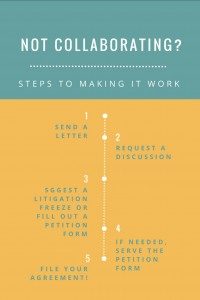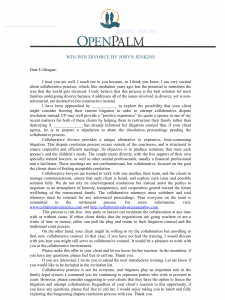If the client’s spouse is not represented by counsel, send a letter to him or her. In it, explain that the client has requested your help in obtaining a divorce and that your client is interested in proceeding by using the collaborative process, and provide the contact information of several collaboratively-trained attorneys. Provide him with the website information for your local practice group. Give him the information so that he can research on the IACP website, as well.

Request that he contact you to discuss the possibility of proceeding collaboratively within a certain period of time. If he does not contact you within two weeks, reach out to him again. Try a different form of communication, perhaps by phone or by e-mail. (Different people are comfortable with different forms of communication.) You may want to try a text message; if you do, be sure to identify yourself. Leave messages, asking for a response.
Some attorneys do not agree that this practice is appropriate. However, you are discussing the choices of process, not the law, and you will be offering no legal advice. In fact, you should make that clear to the client’s spouse, as well as to your client.
If the client’s spouse is represented by counsel, reach out to his counsel to ascertain whether she is collaboratively-trained or is interested in collaborative training, and to inquire as to whether she would be interested in proceeding with a collaborative divorce.

If a divorce petition has already been filed, suggest to the client’s spouse or to his counsel a “litigation freeze” so that the parties can attempt the collaborative process.
Once you have reached out to the client’s spouse about the collaborative process and followed up, if he still has not responded, you may need to file a divorce petition to get his attention. In that case, consider filing it, but not serving it. Then send another letter to the client’s spouse with the petition, explaining that, although you have filed the petition because he has not responded, your client is still open to proceeding with a collaborative divorce.

If the client’s spouse is still non-responsive, you may need to have him served with the petition to get his attention. This is unfortunate, but the proceedings can always be abated if the parties decide to proceed with collaboration. In that case, file the participation agreement and notify the clerk that the case is now on the collaborative method track, rather than the litigation track, so all set hearings and case management conference should be cancelled.
Remember that, at any point in the process, the parties can opt to freeze the litigation and collaborate. However, if you signed the client as a collaborative case, and the other party refuses to proceed using the collaborative process, you should require your client to sign a new litigation retainer agreement, and, perhaps, provide a retainer fee, if you only offer your pro bono services for collaborative divorces.
Need advice now? Contact Joryn!
About this week’s author: Joryn Jenkins.
Joryn, family attorney and Open Palm Founder, began her own firm here in Tampa after a 14-year career in law while also serving as a full-time professor in law at Stetson University. She is a recipient of the prestigious A. Sherman Christensen award, an honor bestowed upon those who have provided exceptional leadership to The American Inns of Court Movement. For more information on Joryn’s professional experience, take a look at her resume.












